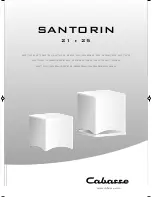
Wiring
The Kicker CompVR woofers are available with dual 2 Ohm and dual 4 Ohm voice coils. Both coils should always be hooked up.
The dual 2 Ohm woofer will give you a 1 Ohm or a 4 Ohm load depending on if the coils are wired in parallel or in series. The
dual 4 Ohm woofers will give a 2 Ohm or 8 Ohm load depending on how they are wired. See the illustrations below for wiring
options and the resulting impedance loads.
The terminals with the solid red and black markings are for one voice coil. The terminals with the white dots are for the sec-
ond voice coil.
Parallel Wiring
Series Wiring
Dual 2 Ohm = 1 Ohm load
Dual 2 Ohm = 4 Ohm load
Dual 4 Ohm = 2 Ohm load
Dual 4 Ohm = 8 Ohm load
Box-Building Notes
The material of choice for building a strong box is 3/4" or thicker MDF (Medium Density Fiberboard). HDF (High Density
Fiberboard) is also good, as is a really good grade of plywood (such as marine grade 7 or 13 ply). Regular particle board is not
very good for speaker enclosures. It is flexible and will crumble when you try to screw the woofer in.
All drawings and measurements in this manual assume 3/4" material.
The peak pressure in a ported box can exceed that of a sealed enclosure. All of these designs need
some internal bracing. Be sure to add 2"x2" to 3"x3" triangle braces between each of the larger
unsupported panels. Cross bracing is also a good idea to help reduce panel vibration. Strips of 3/4"
by 2" wood work well for tying the panels together.
A good grade of wood glue is recommended for joining two pieces of wood together along with
1 1/4” to 1 1/2" drywall screws or 1 1/2" staples. A fastener placed about every 3" will hold the box
together good enough until the glue dries.
After assembling the box and allowing the glue to set up, use silicone sealer to make absolutely
sure the corners are perfectly sealed. Hint: When assembling the enclosure, build the whole enclo-
sure except for the rear baffle opposite the woofer cutout. This way you can easily reach inside to apply the silicone sealer. Once
this is done, put the rear panel on and seal it by reaching through the woofer cutout.
If you prefer an ultra-smooth bass response, you should loosely fill your ported Kicker Comp enclosure with polyfil. If you do
so, the entrance to the port (inside the box) must be covered with hardware cloth, chicken wire, or expanded metal to prevent
the polyfil from being blown out through the port. Use of polyfil will slightly decrease efficiency, but will deepen and extend low
bass response.
All sealed boxes should be 50% filled with loose polyfil.
Do not install a ported box with the port against a solid surface. The port opening must remain unobstructed. Use the small-
est dimension of the rectangular port as the minimum amount of space required between the port and any surface to insure
unrestricted airflow.
A common source of air leaks is the connecting wire for the woofers. Terminal cups are commonly available and are
recommended. They provide an airtight means for bringing the wire into the enclosure and allow for easy wiring changes. An
alternative is to drill a hole slightly larger than the wire and seal carefully with silicone sealer. Do not disturb the silicone until it
has set up. Moving the wire before the silicone has set up will usually cause an air leak.
If you carpet the enclosure it is important to cut the carpet around the woofer opening. It is hard to get a good seal if you
have both the gasket and carpet between the woofer and the wood.
On a sealed enclosure it is easy to test the seal of the box. Push the cone in all the way and let it go. If the seal is good, the
cone should take at least five seconds to return to the center position. If the cone springs back faster than that you have a leak
somewhere in the enclosure. Sometimes you can hear air escaping around the woofer or at one of the joints in the enclosure. If
the box itself leaks take the woofer out and check the silicone seal all around the inside. If the air is leaking out around the
woofer try adding a flexible sealer like plumber's putty or rope caulk. Don't use silicone sealers around the woofer.
For more advice on box building, see the Choosing and Building Enclosures page in the Tech Tips & FAQ section of the
Support area on the Kicker website, www.kicker.com.
All the cubic feet numbers given in this manual include the displacement of the woofer.
For the ported boxes the displacement of the port must be added to the final design. It will be impractical to use round ports
for these designs. The rectangular port information given will yield the best results. Also it is very important to round over the
edges of the port opening and both sides of the end of the port that sticks inside the box.
x=2”
x
x
x
x
x
x


























